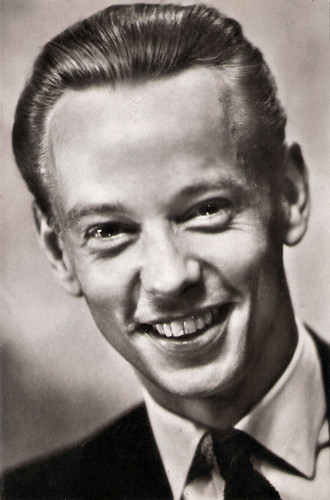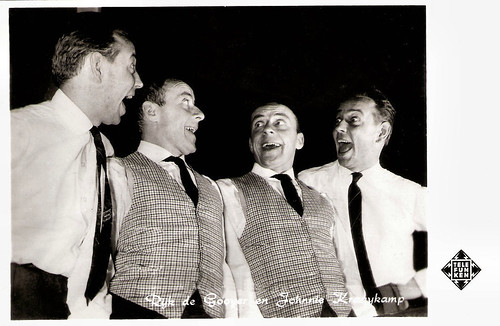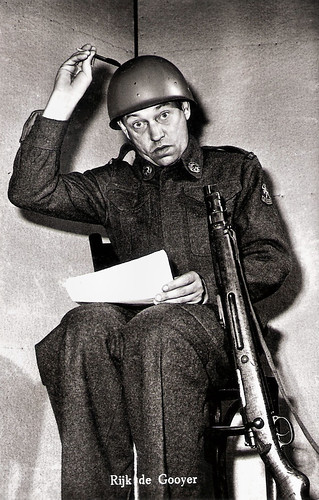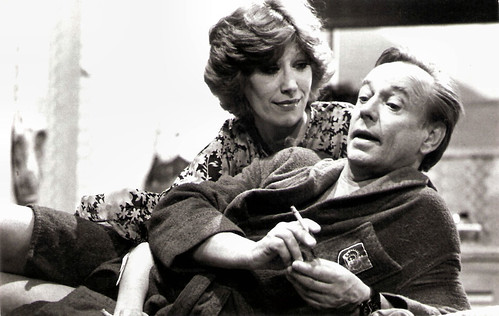Every year in early autumn, the Netherlands Film Festival (NFF) takes place. For ten days, the city of Utrecht is the cinema capital of the Netherlands. From 23 September to 2 October, we join the fun with our own Netherlands Film Star Postcards Festival (NFSPF). We start this little festival today with an actor who was the winner of the Gouden Kalf Award (the Gold Calf, the main award at the NFF) in 1982, 1995 and 1999! Rijk de Gooyer (1925–2011) was one of the major stars of the Dutch cinema. From the 1950s until the early 1970s, he became well-known as part of a comic duo with Johnny Kraaijkamp, Sr. Later he starred in successful Dutch films like De inbreker (1972) and Soldaat van Oranje (1977). He also appeared in international films such as The Wilby Conspiracy (1975) and Nosferatu: Phantom der Nacht (1979).

Dutch postcard. Photo: Godfried de Groot.
Rijk de Gooyer was born in Utrecht, Netherlands, in 1925 as one half of a fraternal twin. His father was a baker.
At the end of World War II, Rijk worked as an interpreter. Initially for the American 101st Airborne, and later on for the British Field Security. One of his first screen credits was a part in the American TV series Secret File, U.S.A. (1955), filmed in the Netherlands for syndicated TV in the USA.
He also played in the Dutch films Het wonderlijke Leven van Willem Parel/The amazing life of Willem Parel (Gerard Rutten, 1955) featuring Wim Sonneveld, and Kleren maken de man/Clothes make the man (Georg Jacoby, 1957), starring Kees Brusse.
From 1959 till 1961 de Gooyer studied at an actors school of the Ufa in Berlin. During these years, he would have worked for the CIA as an informant. In Germany, he appeared in the film Schachnovelle/Brainwashed (Gerd Oswald, 1960) starring Curd Jürgens. Back in the Netherlands, he played parts in the crime films Rififi in Amsterdam (Giovanni Korporaal, 1962) and De blanke Slavin/The White Slave (Rene Daalder, 1969).
In the 1950s, he started a comic duo with Johnny Kraaykamp. Thanks to their performances on TV, the duo became extremely popular. In the Johnny & Rijk shows on TV, De Gooyer always played the part of the feeder, with Kraaijkamp providing the laughs. They split up in the 1970s when De Gooyer focused more on his film career.

Rijk de Gooijer and Johnny Kraaykamp. Dutch postcard by Editions Altona, Amsterdam / Gebr. Spanjersberg, Rotterdam. Photo: Telefunken.

Dutch postcard by Gebr. Spanjersberg N.V., Rotterdam (Sparo), no. 1111. Photo: Artone. The song 'Brief uit La Courtine' (Letter from La Courtine) was written by Eli Asser and was a hit in 1964.
Rijk de Gooyer played his first lead role in the cinema as master safe-cracker Glimmie in the crime film De inbreker/The Burglar (Frans Weisz, 1972). Martin Smith at IMDb: “Rijk de Gooyer is at his best in this movie. Like in real life, Rijk is humorous, tough and resourceful. John Blooming (sic, Jon Bluming), a Dutch martial arts expert and trainer of the Dutch Olympic Karate team a long time ago, plays the role of the big, strong but not too bright sidekick very convincing. His massive appearance says more than words. I saw this movie many years ago and it always stuck in my mind.”
The success of the film led to other lead roles in thrillers like Naakt over de schutting/Naked Over the Fence (Frans Weisz, 1973) with Jon Bluming and Sylvia Kristel, and Rufus (Samuel Meyering, 1975) with Cox Habbema. He also played a supporting part in the British anti-apartheid thriller The Wilby Conspiracy (Ralph Nelson, 1975), starring Michael Caine and Sidney Poitier.
Memorable is his role as a Gestapo agent in the war film Soldaat van Oranje/Soldier of Orange (Paul Verhoeven, 1977). The film, starring Rutger Hauer and Jeroen Krabbé, became one of the most successful films of Dutch cinema. Another masterpiece was Werner Herzog’s Nosferatu: Phantom der Nacht/Nosferatu the Vampyre (1979) with Klaus Kinski as Count Dracula. De Gooyer played a supporting role as a town official.
De Gooijer continued to appear regularly in Dutch and international films. His best films include Een vlucht regenwulpen/A flight of rainbirds (Ate de Jong, 1981), Vroeger kon je lachen/One Could Laugh in Former Days (Bert Haanstra, 1983) and Ciske de Rat/ Ciske the Rat (Guido Pieters, 1984). In 1982 he won the Golden Calf at the NFF for Best Actor for all his works. He played excellent roles in interesting films like the Jewish drama Leedvermaak/Polonaise (Frans Weisz, 1989) and the literary adaptation De avonden/Evenings (Rudolf van den Berg, 1989) as the father of Frits van Egters (Thom Hoffman). In 1995 he again won the Golden Calf for his role as a former vaudevillian who tries one last time to find the dignity of a legitimate role in Hoogste Tijd/The Last Call (Frans Weisz, 1995). De Gooyer was videotaped afterwards while he threw the award out of the window of a cab for the TV show Taxi (the Dutch version of Taxicab Confessions).
His last Golden Calf, for Madelief, Krassen in het Tafelblad/Daisy (Ineke Houtman, 1998) was also thrown out on the street, this time by his friend Maarten Spanjer who hosted Taxi. De Gooyer was also the lead in the TV series In voor- en tegenspoed/In Sickness and in Health (1991-1997), the Dutch version of Johnny Speight's sitcom franchise known in the UK as Till Death Us Do Part and in the US as All in the Family. De Gooyer played Fred Schuit, the Dutch equivalent of Alf Garnett or Archie Bunker. He won a Golden Film in 1997 for the role. His final film was Happy End (Frans Weisz, 2009). Rijk de Gooyer died in 2011 in Amsterdam, Netherlands. He was 85. He was married to Tonny Domburg, sister of actress Andrea Domburg.

Dutch postcard. Publicity still for the TV film Quitte of dubbel/Double or quits (Hank Onrust, 1977) with Ronnie Bierman.
Rijk de Gooijer & Johnny Kraaykamp perform their hit song 'Waterlooplein' in one of their TV shows. Source: mervinproducties (YouTube).
The legendary fragment from Taxi (1995). Source: Kanaal van 1000birds (YouTube).
Sources: Martin Smith (IMDb), AllMovie, Wikipedia and IMDb.
This post was last updated on 14 June 2024.

Dutch postcard. Photo: Godfried de Groot.
Informant for the CIA in Berlin
Rijk de Gooyer was born in Utrecht, Netherlands, in 1925 as one half of a fraternal twin. His father was a baker.
At the end of World War II, Rijk worked as an interpreter. Initially for the American 101st Airborne, and later on for the British Field Security. One of his first screen credits was a part in the American TV series Secret File, U.S.A. (1955), filmed in the Netherlands for syndicated TV in the USA.
He also played in the Dutch films Het wonderlijke Leven van Willem Parel/The amazing life of Willem Parel (Gerard Rutten, 1955) featuring Wim Sonneveld, and Kleren maken de man/Clothes make the man (Georg Jacoby, 1957), starring Kees Brusse.
From 1959 till 1961 de Gooyer studied at an actors school of the Ufa in Berlin. During these years, he would have worked for the CIA as an informant. In Germany, he appeared in the film Schachnovelle/Brainwashed (Gerd Oswald, 1960) starring Curd Jürgens. Back in the Netherlands, he played parts in the crime films Rififi in Amsterdam (Giovanni Korporaal, 1962) and De blanke Slavin/The White Slave (Rene Daalder, 1969).
In the 1950s, he started a comic duo with Johnny Kraaykamp. Thanks to their performances on TV, the duo became extremely popular. In the Johnny & Rijk shows on TV, De Gooyer always played the part of the feeder, with Kraaijkamp providing the laughs. They split up in the 1970s when De Gooyer focused more on his film career.

Rijk de Gooijer and Johnny Kraaykamp. Dutch postcard by Editions Altona, Amsterdam / Gebr. Spanjersberg, Rotterdam. Photo: Telefunken.

Dutch postcard by Gebr. Spanjersberg N.V., Rotterdam (Sparo), no. 1111. Photo: Artone. The song 'Brief uit La Courtine' (Letter from La Courtine) was written by Eli Asser and was a hit in 1964.
The Burglar and Nosferatu
Rijk de Gooyer played his first lead role in the cinema as master safe-cracker Glimmie in the crime film De inbreker/The Burglar (Frans Weisz, 1972). Martin Smith at IMDb: “Rijk de Gooyer is at his best in this movie. Like in real life, Rijk is humorous, tough and resourceful. John Blooming (sic, Jon Bluming), a Dutch martial arts expert and trainer of the Dutch Olympic Karate team a long time ago, plays the role of the big, strong but not too bright sidekick very convincing. His massive appearance says more than words. I saw this movie many years ago and it always stuck in my mind.”
The success of the film led to other lead roles in thrillers like Naakt over de schutting/Naked Over the Fence (Frans Weisz, 1973) with Jon Bluming and Sylvia Kristel, and Rufus (Samuel Meyering, 1975) with Cox Habbema. He also played a supporting part in the British anti-apartheid thriller The Wilby Conspiracy (Ralph Nelson, 1975), starring Michael Caine and Sidney Poitier.
Memorable is his role as a Gestapo agent in the war film Soldaat van Oranje/Soldier of Orange (Paul Verhoeven, 1977). The film, starring Rutger Hauer and Jeroen Krabbé, became one of the most successful films of Dutch cinema. Another masterpiece was Werner Herzog’s Nosferatu: Phantom der Nacht/Nosferatu the Vampyre (1979) with Klaus Kinski as Count Dracula. De Gooyer played a supporting role as a town official.
De Gooijer continued to appear regularly in Dutch and international films. His best films include Een vlucht regenwulpen/A flight of rainbirds (Ate de Jong, 1981), Vroeger kon je lachen/One Could Laugh in Former Days (Bert Haanstra, 1983) and Ciske de Rat/ Ciske the Rat (Guido Pieters, 1984). In 1982 he won the Golden Calf at the NFF for Best Actor for all his works. He played excellent roles in interesting films like the Jewish drama Leedvermaak/Polonaise (Frans Weisz, 1989) and the literary adaptation De avonden/Evenings (Rudolf van den Berg, 1989) as the father of Frits van Egters (Thom Hoffman). In 1995 he again won the Golden Calf for his role as a former vaudevillian who tries one last time to find the dignity of a legitimate role in Hoogste Tijd/The Last Call (Frans Weisz, 1995). De Gooyer was videotaped afterwards while he threw the award out of the window of a cab for the TV show Taxi (the Dutch version of Taxicab Confessions).
His last Golden Calf, for Madelief, Krassen in het Tafelblad/Daisy (Ineke Houtman, 1998) was also thrown out on the street, this time by his friend Maarten Spanjer who hosted Taxi. De Gooyer was also the lead in the TV series In voor- en tegenspoed/In Sickness and in Health (1991-1997), the Dutch version of Johnny Speight's sitcom franchise known in the UK as Till Death Us Do Part and in the US as All in the Family. De Gooyer played Fred Schuit, the Dutch equivalent of Alf Garnett or Archie Bunker. He won a Golden Film in 1997 for the role. His final film was Happy End (Frans Weisz, 2009). Rijk de Gooyer died in 2011 in Amsterdam, Netherlands. He was 85. He was married to Tonny Domburg, sister of actress Andrea Domburg.

Dutch postcard. Publicity still for the TV film Quitte of dubbel/Double or quits (Hank Onrust, 1977) with Ronnie Bierman.
Rijk de Gooijer & Johnny Kraaykamp perform their hit song 'Waterlooplein' in one of their TV shows. Source: mervinproducties (YouTube).
The legendary fragment from Taxi (1995). Source: Kanaal van 1000birds (YouTube).
Sources: Martin Smith (IMDb), AllMovie, Wikipedia and IMDb.
This post was last updated on 14 June 2024.
No comments:
Post a Comment